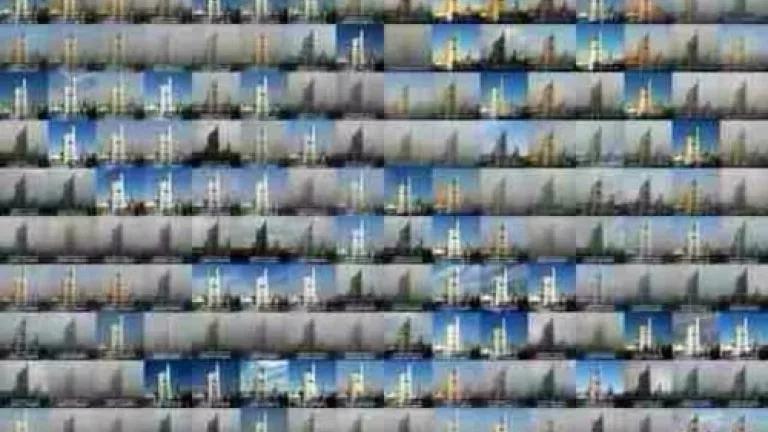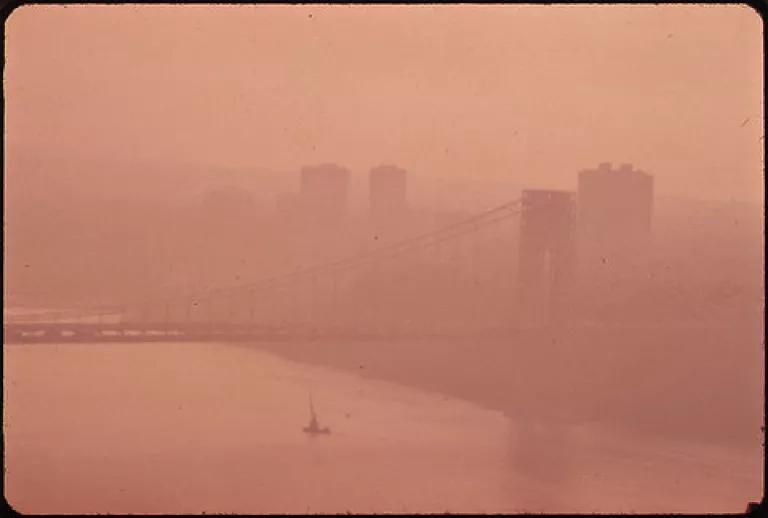
My colleagues in China just sent me this fascinating image posted on Weibo, the Chinese Twitter. It’s a collage of photos of the sky over Beijing, taken from the same spot every weekday for about a year, between March 2012 and March 2013. Here, in 256 shades of gray, brown, and the occasional blue, is the sky that Beijing residents look out on every working day.

(Photo credit: Chester Higgins Jr.)
In case you can’t make it out, that’s the George Washington Bridge, barely visible through the haze. In truth, we’re not so far removed from the pollution China is battling right now. But we tend to take “blue sky days” and our bridge views for granted because we’ve been reaping the benefits of 40 years of strong, dedicated, clean air laws.
When I last visited China, my days in Beijing and Chengdu were spent under a blanket of haze. Some days I could taste metal on my lips when we ventured outdoors. Experiencing Chinese air pollution never fails to bring home to me how vital—literally—strong clean air laws are for any country.
Air pollution causes billions of dollars in environmental damages in China, shortens life spans, and is a source of increasing public anxiety about individual health and the state of China’s environment. That’s why China’s State Council recently unveiled a long-awaited Atmospheric Pollution Prevention Action Plan.
China’s new plan aims to improve the air quality of the entire country by 2017 by reducing pollution in certain areas, including Beijing, pledges to reduce coal consumption in key regions, limit the number of automobiles on the road, and increase wind and solar power, among other measures.
These are all steps in the right direction, and NRDC has been working in China for more than a decade to promote solutions like this. China has also recently adopted limits on the most dangerous air pollution, the fine particles known as PM 2.5. This pollutant is now being monitored in all major cities--the next key step is to effectively reduce it.
Fine particle pollution stems from two major sources: vehicle exhaust and burning coal. Coal is the source of 75 percent of China’s energy, making it a deadly source of air pollution in the country as well as a major contributor to global carbon emissions. In total, China already consumes nearly as much coal as the rest of the world combined, and still plans to open new coal-fired power plants.
China’s leaders are well aware that the country’s appetite for coal is not sustainable. The new plan allows regions to set their own limits on coal use, which is a good start. However, a binding, national coal cap will be a critical lever to push forward China’s existing clean energy policies and produce real results.
NRDC is working with Chinese partners to recommend an effective, achievable national coal consumption cap for China. We’re working with partners in provincial governments to reduce coal consumption, much as we’re attempting to do in the United States: by encouraging the use of more efficient industrial technologies, like combined heat and power; switching older plants to cleaner fuels; improving data collection and information disclosure of emissions; and developing more tools for better enforcement of existing regulations.
In the United States, brown, hazy skies are a thing of the past, thanks to the strong clean air safeguards inspired by a conscious and motivated public. Today, our Clean Air Act continues to save lives by tackling the deadly pollution we can’t see, such as PM 2.5. And we’re seeing how clean air laws generate economic benefits, not only in lives saved and productivity gained, but in creating new business opportunities in clean technologies and efficiency. The Clean Air Act also gives President Obama the authority to regulate our biggest source of global warming pollution—existing power plants. In doing so, he could spur the creation of hundreds of thousands of jobs.
Strong, well-enforced, and publicly supported clean air laws can be a powerful tool for any government. In the United States as well as in China, clean air protections can protect public health, spur new business opportunities, and help transition away from coal and into a cleaner energy economy. With its new plan, the Chinese government has signaled that it is taking air pollution seriously, and that it’s ready to implement solutions.
And by keeping a close watch on the sky, and on polluters, the Chinese people are doing their part: letting the government know that they are aware of the problem, and that they expect solutions that work.
